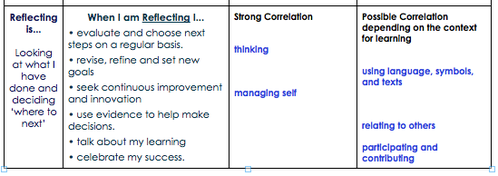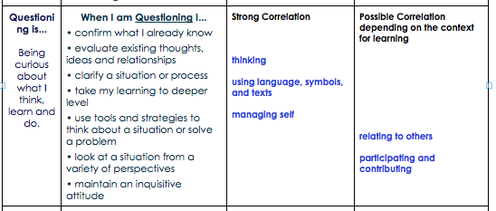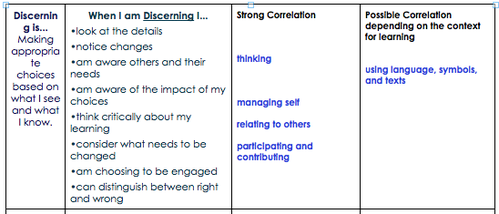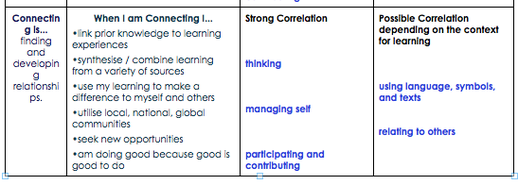Learning Competencies / Key Competencies

Term 3, 2011
Questioning

Term 3, 2011
Discerning

Term 3, 2011
Connecting

Assessing Learning Competencies at Reremoana School
Key Questions:
Fostering lifelong learning:
Key:
Assessment:
Two components to trial
A Learning Journal - Use their journal to set clear competency learning goals, record evidence of their success in meeting these, and reflect on their ongoing learning needs.
* Consideration when using Rubrics
Capabilities for living and lifelong learning
The New Zealand Curriculum identifies five key competencies:
Thinking is about using creative, critical, and metacognitive processes to make sense of information, experiences, and ideas. These processes can be applied to purposes such as developing understanding, making decisions, shaping actions, or constructing knowledge. Intellectual curiosity is at the heart of this competency.
Students who are competent thinkers and problem-solvers actively seek, use, and create knowledge. They reflect on their own learning, draw on personal knowledge and intuitions, ask questions, and challenge the basis of assumptions and perceptions.
Using language, symbols, and texts
Using language, symbols, and texts is about working with and making meaning of the codes in which knowledge is expressed. Languages and symbols are systems for representing and communicating information, experiences, and ideas. People use languages and symbols to produce texts of all kinds: written, oral/aural, and visual; informative and imaginative; informal and formal; mathematical, scientific, and technological.
Students who are competent users of language, symbols, and texts can interpret and use words, number, images, movement, metaphor, and technologies in a range of contexts. They recognise how choices of language, symbol, or text affect people’s understanding and the ways in which they respond to communications. They confidently use ICT (including, where appropriate, assistive technologies) to access and provide information and to communicate with others.
Managing self
This competency is associated with self-motivation, a “can-do” attitude, and with students seeing themselves as capable learners. It is integral to self-assessment.
Students who manage themselves are enterprising, resourceful, reliable, and resilient. They establish personal goals, make plans, manage projects, and set high standards. They have strategies for meeting challenges. They know when to lead, when to follow, and when and how to act independently.
Relating to others
Relating to others is about interacting effectively with a diverse range of people in a variety of contexts. This competency includes the ability to listen actively, recognise different points of view, negotiate, and share ideas.
Students who relate well to others are open to new learning and able to take different roles in different situations. They are aware of how their words and actions affect others. They know when it is appropriate to compete and when it is appropriate to co-operate. By working effectively together, they can come up with new approaches, ideas, and ways of thinking.
Participating and contributing
This competency is about being actively involved in communities. Communities include family, whānau, and school and those based, for example, on a common interest or culture. They may be drawn together for purposes such as learning, work, celebration, or recreation. They may be local, national, or global. This competency includes a capacity to contribute appropriately as a group member, to make connections with others, and to create opportunities for others in the group.
Students who participate and contribute in communities have a sense of belonging and the confidence to participate within new contexts. They understand the importance of balancing rights, roles, and responsibilities and of contributing to the quality and sustainability of social, cultural, physical, and economic environments.
- Do we want assessment information about the Learning Competencies for the purposes we already know, or might there be new purposes here as well?
- Do we actually need to assess the Learning Competencies?
- Do the Learning Competencies introduce different types of assessment challenges, and how should we respond to these challenges?
Fostering lifelong learning:
- Actively includes the student in all aspects of decision making.
- Students are actively involved in assessing their own learning and in thinking about their success in terms of learning to learn.
- AIM OF EMPOWERING THEM TO CONTINUE LEARNING AT AND BEYOND SCHOOL.
Key:
- Students must be central in the judgements and decision making about their learning.
- Conversations with students about their strengths and goals as learners will be important.
- When making judgements about competency, different types of evidence (journalling) should be collected.
- More than one person is involved in making judgements
Assessment:
Two components to trial
- Rubric - Level One - Level Four
- Learning Journal - over time the students will create a rich collection of personal stories about themselves and their maths journey and there ability to question appropriately.
A Learning Journal - Use their journal to set clear competency learning goals, record evidence of their success in meeting these, and reflect on their ongoing learning needs.
* Consideration when using Rubrics
- Rubrics typically differentiate between levels of performance at one moment in time and are based on one source of evidence.
- Only one aspect of a task can be manageably assessed
- Contexts are not usually taken into account (very general)
- Rubrics - students are judged by others
- Importance of the learning journal
- Self Assessment
- You have never "achieved" a competency we are all still on a journey!
Capabilities for living and lifelong learning
The New Zealand Curriculum identifies five key competencies:
- thinking
- using language, symbols, and texts
- managing self
- relating to others
- participating and contributing
Thinking is about using creative, critical, and metacognitive processes to make sense of information, experiences, and ideas. These processes can be applied to purposes such as developing understanding, making decisions, shaping actions, or constructing knowledge. Intellectual curiosity is at the heart of this competency.
Students who are competent thinkers and problem-solvers actively seek, use, and create knowledge. They reflect on their own learning, draw on personal knowledge and intuitions, ask questions, and challenge the basis of assumptions and perceptions.
Using language, symbols, and texts
Using language, symbols, and texts is about working with and making meaning of the codes in which knowledge is expressed. Languages and symbols are systems for representing and communicating information, experiences, and ideas. People use languages and symbols to produce texts of all kinds: written, oral/aural, and visual; informative and imaginative; informal and formal; mathematical, scientific, and technological.
Students who are competent users of language, symbols, and texts can interpret and use words, number, images, movement, metaphor, and technologies in a range of contexts. They recognise how choices of language, symbol, or text affect people’s understanding and the ways in which they respond to communications. They confidently use ICT (including, where appropriate, assistive technologies) to access and provide information and to communicate with others.
Managing self
This competency is associated with self-motivation, a “can-do” attitude, and with students seeing themselves as capable learners. It is integral to self-assessment.
Students who manage themselves are enterprising, resourceful, reliable, and resilient. They establish personal goals, make plans, manage projects, and set high standards. They have strategies for meeting challenges. They know when to lead, when to follow, and when and how to act independently.
Relating to others
Relating to others is about interacting effectively with a diverse range of people in a variety of contexts. This competency includes the ability to listen actively, recognise different points of view, negotiate, and share ideas.
Students who relate well to others are open to new learning and able to take different roles in different situations. They are aware of how their words and actions affect others. They know when it is appropriate to compete and when it is appropriate to co-operate. By working effectively together, they can come up with new approaches, ideas, and ways of thinking.
Participating and contributing
This competency is about being actively involved in communities. Communities include family, whānau, and school and those based, for example, on a common interest or culture. They may be drawn together for purposes such as learning, work, celebration, or recreation. They may be local, national, or global. This competency includes a capacity to contribute appropriately as a group member, to make connections with others, and to create opportunities for others in the group.
Students who participate and contribute in communities have a sense of belonging and the confidence to participate within new contexts. They understand the importance of balancing rights, roles, and responsibilities and of contributing to the quality and sustainability of social, cultural, physical, and economic environments.
